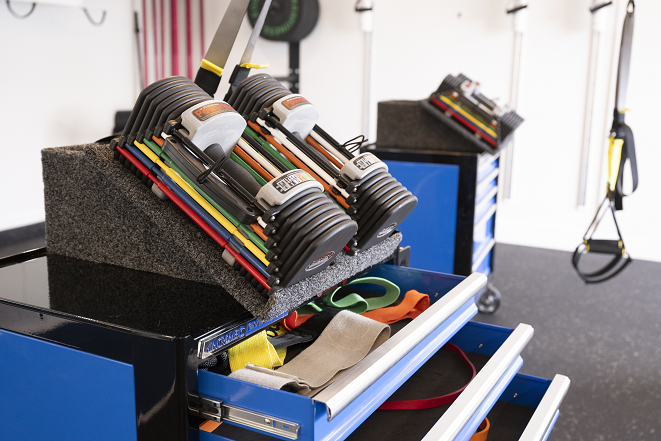
Joining a gym can be a game-changer for anyone recovering from injury or illness. Home-based exercises are valuable — they improve mobility, maintain strength and support early-stage recovery — but a well-equipped gym opens up far greater possibilities for an effective, safe and timely rehabilitation programme. This post explains why a gym environment, combined with guidance from a physiotherapist or an accredited exercise physiologist, often produces better outcomes than exercising at home alone.
Why home exercise alone can be limiting Home-based programs are practical, low-cost and convenient.
They are ideal for early-stage rehab, for practicing movement patterns, and for maintaining consistency. However, they can become limiting as you progress and need to: increase resistance safely, vary movement planes, add load-bearing activities, or challenge cardiovascular fitness in a controlled way. Many home exercises rely on bodyweight or resistance bands, which are helpful but can’t always provide the fine-grained progression or the specific loading angles required to rebuild strength, correct movement impairments, or restore high-level function.
How the gym expands your rehabilitation toolbox
A modern gym offers a wide range of equipment that allows for progressive, targeted and varied therapeutic exercise:
- Resistance machines: Seated and selectorised machines provide controlled, repeatable resistance and are excellent for isolating weak muscle groups while minimising compensatory movements. This is especially useful after joint surgery or when pain limits free-weight work.
- Free weights and barbells: For later-stage rehabilitation, free weights allow practitioners to restore functional strength, balance and core stability through multi-joint lifts such as squats and deadlifts, under progressive loading.
- Cable and pulley systems: These enable movement in multiple planes and angles, replicating real-world tasks and sports-specific patterns that are difficult to mimic at home.
- Cardio machines (treadmill, bike, rower, elliptical): These tools let clinicians precisely control speed, intensity, incline and duration to rebuild aerobic capacity while monitoring symptom response.
- Functional training equipment (TRX, kettlebells, medicine balls, sleds): These devices help restore dynamic control, power and coordination for activities of daily living or sporting return-to-play.
- Balance and proprioception tools (BOSU, wobble boards, foam pads): Essential for retraining joint stability, especially after ankle, knee and hip injuries.
- Specialist clinical equipment: Many clinic gyms have isokinetic machines, anti-gravity treadmills or electrotherapy devices that aren’t feasible to have at home but are invaluable for measured, progressive loading and objective assessment.
Why professional supervision matters
Access to equipment by itself isn’t enough. The real advantage comes when gym resources are combined with professional oversight. Physiotherapists and exercise physiologists are trained to assess tissue healing, movement quality and cardiovascular tolerance, then prescribe and progress exercises safely. They can:
- Individualise loading: Decide when to move from bands to weights, and by how much, to avoid setbacks while achieving strength gains.
- Monitor technique and reduce compensations: Ensure correct movement patterns to prevent new injuries and improve long-term outcomes.
- Progress rehabilitation logically: Move through phases — protection, mobility, strength, power, and return to function — using appropriate gym tools for each step.
- Use objective measures: Track strength, endurance and range-of-motion gains using gym equipment, helping motivate patients and guide decisions.
- Manage comorbidities: Exercise physiologists are particularly skilled at tailoring cardiovascular and metabolic conditioning for people with chronic conditions alongside injury rehab.
Practical, evidence-informed resources and support
If you want to understand professional standards or find accredited practitioners, refer to peak bodies such as Exercise & Sports Science Australia (for exercise physiology) (https://essa.org.au/) and the Australian Physiotherapy Association (for physiotherapy) (https://australian.physio/). These organisations provide guidance on scope of practice and how allied health professionals support safe, effective rehabilitation. For clear patient-facing information about rehabilitation and recovery, the Better Health Channel offers useful fact sheets and practical advice (https://betterhealth.vic.gov.au/).
Combining gym-based and home exercise for best results
A hybrid approach often works best: use home exercises to reinforce daily mobility and adherence, and gym sessions to progress strength, cardio and functional retraining. Start with clinical supervision — for example, book a consultation with a physiotherapist to review your rehab program https://holisticphysiofitness.com.au/services/physiotherapy). Later, integrate sessions with an accredited exercise physiologist for chronic conditions or cardiovascular work https://holisticphysiofitness.com.au/services/exercise-physiology/). If you’d like help creating a gym-based plan or finding the right facility, contact our team.
Psychological and social benefits Gyms also offer motivational and social advantages that support adherence. Supervised sessions, small group classes run by exercise professionals, or just the regular routine of attending a facility can improve consistency. Many people find they work harder and progress faster in a structured environment than when exercising alone at home.
Tips for choosing the right gym for rehab
- Look for a facility with a variety of equipment and staff who understand injury rehabilitation, or a community/hospital gym that offers allied health-led sessions.
- Ensure the gym allows supervised clinical sessions and has clear safety procedures.
- Ask about trial sessions or orientation for people recovering from injury so you learn how to use machines safely.
Conclusion Home exercise is important, but a gym environment expands the tools available to physiotherapy and exercise physiology, enabling more precise, progressive and functional rehabilitation. With professional guidance, gym-based rehab can speed recovery, reduce the risk of re-injury and better prepare you for everyday life or a return to sport. Speak with your physiotherapist or accredited exercise physiologist about how to safely integrate gym-based sessions into your rehabilitation programme, and consider reviewing resources from ESSA (https://essa.org.au/) and the Australian Physiotherapy Association (https://australian.physio/) for further information. If you’d like help getting started, visit our physiotherapy and exercise physiology pages.

When diagnosed with cancer, the journey ahead can feel daunting. With the physical and emotional challenges that come with treatment, many people often wonder how they can maintain their strength and quality of life. One powerful tool that’s gaining recognition in cancer care is exercise. From maintaining muscle mass during chemotherapy to improving overall well-being, exercise has shown to provide significant benefits for cancer patients. Exercise physiology plays a key role in understanding these benefits and developing safe, effective exercise programs tailored to each individual’s needs.
Why is Exercise Important for Cancer Patients?
Cancer treatment, such as chemotherapy, radiotherapy, and surgery, can be physically taxing. Patients often experience fatigue, muscle wasting, weight loss, and a decrease in strength and endurance. These effects can have a significant impact on daily activities and overall quality of life. However, research shows that exercise can help mitigate these side effects, improving both physical and emotional health.
Exercise can be defined as any planned, structured, and repetitive physical activity that improves or maintains physical fitness. For cancer patients, regular exercise helps reduce the impact of cancer-related fatigue, boosts energy levels, strengthens the immune system, and supports the maintenance of muscle mass and bone density. Exercise physiology focuses on understanding the body’s response to physical activity, and this knowledge is crucial when designing exercise programs for cancer patients.
Maintaining Muscle Mass During Chemotherapy
One of the most concerning effects of chemotherapy is muscle wasting, also known as cancer cachexia. This condition leads to a significant loss of muscle mass and strength, which can worsen fatigue and limit mobility. Chemotherapy targets rapidly dividing cells, which include not only cancer cells but also healthy cells, such as those in muscles. As a result, patients often experience a loss of lean body mass, making it harder to perform everyday tasks.
Exercise, particularly resistance training, has been shown to be effective in countering muscle loss and promoting muscle retention during chemotherapy. Studies have found that engaging in strength-based exercises, such as lifting weights or using resistance bands, can stimulate muscle growth and prevent further deterioration. The key is to start at a manageable level and gradually increase intensity, ensuring that the body is not overstressed.
Exercise physiology plays an essential role in guiding cancer patients through this process. By designing a program that targets the muscles most affected by treatment, exercise physiologists ensure that patients are engaging in the right exercises in the right way to maintain muscle mass safely. Whether through resistance training, functional movement exercises, or even bodyweight exercises, staying active can help patients preserve their strength during treatment.
The Psychological Benefits of Exercise for Cancer Patients
Aside from the physical benefits, exercise also has a profound impact on mental health. A cancer diagnosis and the stress of treatment can lead to feelings of anxiety, depression, and isolation. Exercise has been shown to improve mood, reduce stress, and help manage symptoms of depression, which are common among cancer patients.
Endorphins, the body’s natural mood-boosting chemicals, are released during exercise, promoting a sense of well-being. Furthermore, the routine and sense of accomplishment associated with exercise can foster a sense of control, which is often lost during the cancer journey. These psychological benefits, in turn, can improve adherence to treatment and enhance overall quality of life.
Reducing the Risk of Cancer Recurrence
Research also suggests that regular exercise can help reduce the risk of cancer recurrence. Studies have shown that patients who engage in moderate physical activity after cancer treatment may experience a lower risk of their cancer returning, particularly in breast, colon, and prostate cancer survivors. Exercise can improve immune function, regulate hormones, and reduce inflammation—all factors that play a role in cancer progression.
While more research is needed to fully understand the mechanisms behind this relationship, the evidence so far is promising. For cancer survivors, staying active can be an important step in long-term health management.
Building a Safe and Effective Exercise Program
When it comes to exercise for cancer patients, safety is key. Every individual’s situation is unique, so it’s important to tailor exercise plans to the person’s specific needs, treatment stage, and fitness level. Exercise physiology plays a crucial role in this process, using scientific knowledge of how the body responds to exercise to create a personalised plan that ensures maximum benefit with minimal risk.
The following are some general guidelines for creating an exercise program for cancer patients:
- Start Slow: Begin with low-intensity exercises such as walking, light stretching, or gentle yoga. As strength improves, you can gradually increase the intensity and duration.
- Incorporate Strength Training: Resistance exercises help build muscle mass and counteract muscle loss due to chemotherapy. However, start with lighter weights or resistance bands, and progressively increase as the body adapts.
- Focus on Flexibility and Balance: Cancer treatments can impact flexibility and balance, so incorporating exercises like stretching and balance training can improve coordination and reduce the risk of falls.
- Stay Hydrated and Rested: It’s crucial to listen to your body. Stay hydrated, rest when needed, and ensure that your exercise program is balanced with recovery periods.
- Consult an Exercise Physiologist: Before beginning any exercise regimen, especially during or after cancer treatment, it’s important to consult with a qualified exercise physiologist. They can design a program tailored to your specific needs and ensure that you are exercising safely.
Conclusion
Exercise plays an essential role in managing the side effects of cancer treatment, improving overall physical and mental health, and supporting the maintenance of muscle mass during chemotherapy. Through the guidance of exercise physiology, cancer patients can enjoy a tailored program that helps them stay active and improve their quality of life. Whether you’re currently undergoing treatment or are a cancer survivor, integrating exercise into your routine can provide numerous benefits, supporting your journey towards better health and wellness.
If you or a loved one is going through cancer treatment, don’t hesitate to consult an exercise physiologist to create a plan that works for you. Your body will thank you for it. Read more HERE

